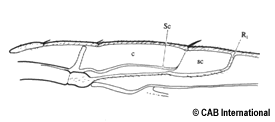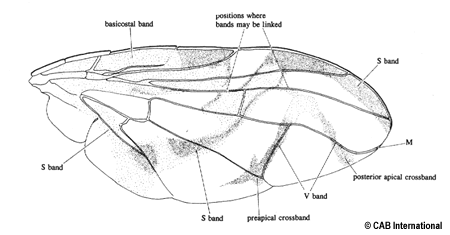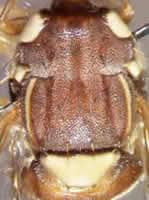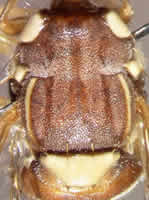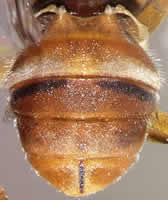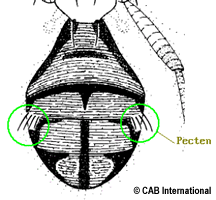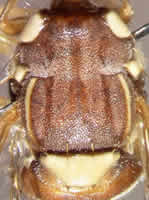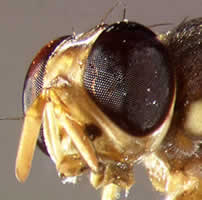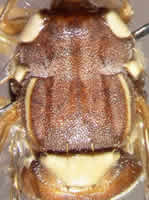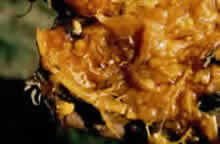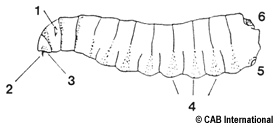
Bactrocera zonata: introduction into the EPPO region and
its identification by Dr Ian M. White
Introduction of Bactrocera zonata into the EPPO region (situation in 2002)
Bactrocera zonata (Diptera: Tephritidae) originates in South and South-East Asia where it attacks many fruit species (more than 50 host plants), including guavas, mangoes, peach, apricots, figs and citrus. It has spread to other parts of the world, in particular to several countries in the Near East and to Egypt. In recent years, B. zonata has become a widespread pest in Egypt, and in addition it has been intercepted in Israel. It is considered that B. zonata threatens countries in the Near East and North Africa, and to a lesser extent in Southern Europe. International cooperation has been initiated by IAEA and FAO to eradicate B. zonata and prevent any further spread. On 2002-03-05, EPPO organized a Workshop in Paris to review the current situation and decide on recommendations to be made to EPPO countries.
In September 2002, the EPPO Council decided to add B. zonata to the EPPO A1 List (the pest was transferred to the A2 List in 2015).
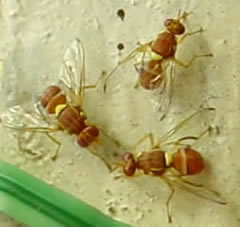
Courtesy Dr. Cayol Joint FAO/IAEA Division
During the EPPO Workshop, participants presented the situation of B. zonata in the following countries:
- Algeria: The NPPO of Algeria intends to start a detection programme for B. zonata. This will be developed through FAO. The Algerian lists of quarantine pests are currently under revision and B. zonata will included in the revised A1 quarantine list.
- Egypt: In 1924, B. zonata was declared present in Egypt based on a detection in an intercepted consignment in Port Said in 1912. For a long period, the pest was no longer mentioned. In the 1980s, an intensive Tephritid fruit fly survey was initiated by FAO, but B. zonata was not found. In 1998, B. zonata was identified for the first time on infested guavas collected in Agamy and Sabahia, near Alexandria. In 1999, the first traps were set up and showed high capture rates in Alexandria and Cairo. In October 2000, B. zonata was detected in North Sinai (District of El Arish). Monitoring was set up in the North Sinai Governorate and 45,000 lure and kill blocks were installed. At present, it is considered that B. zonata is present and widespread in Egypt, and the situation is as follows. Mainland: whole Nile Delta region, Nile Valley, and Kharga and Dakla oases. There are extremely high populations in Cairo (>30 flies per trap per h in downtown Cairo). Sinai peninsula: Ras El Sudr, El Tur and Nuweiba in South Sinai Governorate. Captures all along the North Sinai Governorate (130 km2 of potential hosts) from El Qantara (NW) to Rafah (NE). High populations are found in gardens in El Arish. B. zonata is present on the Israel/TUJPA/Egypt border south of Rafah City. No efficient control action has yet been undertaken. Is was stressed that B. zonata is present even in very dry areas, where few host plants are present, and event on isolated trees. Furthermore, although B. zonata can be found in peach or mango orchards, larger populations are encountered in gardens where several different fruit trees grow in a relatively limited area. Though eradication appears difficult to achieve in the whole country, it might be feasible in the Sinai Peninsula.
- Iran: During the Workshop, it was reported that B. zonata was recently recorded from Southern Iran.
- Israel: B. zonata was found for the first time in November 2000 in Rafah, south of Gaza strip, where a single male was captured. Approximately 20 flies were collected south of the Gaza Strip in Kerem Shalom by the end 2001. More than 700 methyl eugenol-baited traps have been put in place and preventive operations are carried out every two weeks. All detected outbreaks have been eradicated to date.
- Jordan :133 methyl eugenol-baited traps have been put in place, mainly in the Aqaba area and in the Jordan valley, but also in the highlands. Drastic phytosanitary measures have been taken to prevent introduction. Import and even transit of commodities from 13 countries infested or with a high risk of infestation by B. zonata have been prohibited, including Egypt, Oman, Saudi Arabia, Palestine and Israel. Fruits carried by passengers are destroyed. Preventive treatments are not being applied. A Pest Risk Analysis has been conducted in Jordan and lead to the conclusion that B. zonata has the characteristics of a quarantine pest. Legislation for internal phytosanitary measures is currently being formulated. So far, B. zonata has not been found.
- Libya: The situation is not known, but no trapping has apparently been done.
- Syria: The NPPO of Syria has confirmed that B. zonata does not occur in Syria and that a suitable trapping network is in place (EPPO RS 2002/155).
- Territories Under the Jurisdiction of the Palestinian Authorities (TUJPA): Following reports of this pest in Egypt, a network of traps was set up in Gaza (80 traps along the border with Egypt and inside Gaza strip). TUJPA does not import any commodity from countries where the pest is present. Passengers are not allowed to enter the TUJPA with fruits. It should be noted that some highly exposed areas are out of reach for both the Palestinian and Israeli authorities (no man's land). B. zonata has not been found.
- Tunisia: A trapping network using methyl eugenol traps will be put in place with the help of IAEA.
Various habitats in Egypt where B. zonata has been found – Pictures from Dr Cayol, Joint FAO/IAEA Division
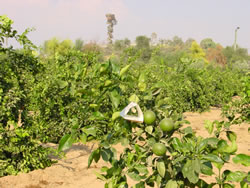
Egyptian infested orchard near Israel/TUJPA

Typical habitat of B. zonata in Egypt

Dry areas (south of El Arish)

Mango orchard near Ismailia
Identification of Bactrocera zonata by Dr Ian M. White
The following page is based on a presentation made by Dr Ian M. White, The Natural History Museum, London, at the EPPO Workshop on Bactrocera zonata (Paris, 2002-03-05/06). All close-up photographs are Copyright of the Natural History Museum, London (2002) and drawings are reproduced with the permission of CABI International.
Identification problems
- There are a lot of fruit flies
- approximately 4000 species and 500 genera of Tephritidae
- almost all phytophagous
- approximately 40% attack fruit
- others in flowers, stems, leaves, roots - Most fruit pests belong to 5 genera
- Bactrocera is the largest of these
- approximately 500 described species
- specialists aware of many more
Collecting methods (specific methods aid identification)
- Fruit rearing
- Tephritidae are the only flies that attack fresh fruit - Methyl eugenol trapping
- only collects males of a restricted set of Bactrocera spp. - Other methods (including use of protein and food baits)
- all potentially collect other families and genera - Conclusion: the rest of this presentation will concentrate on identification of reared and methyl eugenol trapped flies
Fruit rearing and family identification
- Tephritidae usually oviposit into intact fruit
- Other flies in fruit usually do not
- Drosophila spp. (Drosophilidae) associated with fallen, over-ripe or damaged fruit
- Silba and Neosilba (Lonchaeidae) oviposit into holes made by Tephritidae
- Atherigona (Muscidae) usually in damaged fruit.
- Conclusion: if it attacks fruit on the tree it is probably a tephritid.
Fruit rearing and genus identification
- approximately 100 fruit pest Tephritidae
- approximately 90% belong to just 5 genera
- the other 10% are in unusual hosts - Conclusion: if we rear from a mainstream commercial fruit it is almost certainly a member of one of these 5 genera
Methyl eugenol trapping
- Attracts the males of some Bactroceraspp.
- 81 species recorded at methyl eugenol
- 211 species recorded at cue lure
- 33 apparently neither
- 188 unknown response
- Conclusion
- positive response to methyl eugenol helps narrow down the species
- the 211 that go to cue lure can at least be eliminated

Methyl eugenol ...

... can catch an awful lot of flies !

Traps used with methyl eugenol – Morocco trap
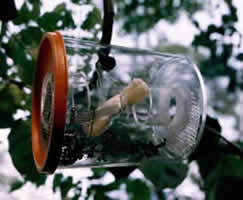
Traps used with methyl eugenol – Steiner trap
Identification of the family Tephritidae
- Most Tephritidae have patterned wings
- a few do not
- some other families also have patterned wings
- The shape of one wing cell needs to be examined to verify identity
- only the family Psylidae (e.g. carrot fly) is similar but they are not in fruit
| Wing veins and family identification | |
 |
|
| Not Tephritidae | Tephritidae (vein Sc bent almost 90 degrees and then reduced to a fold) |
Identification of genera, including Bactrocera
- Five pest genera
- Anastrepha - New World - many hosts
- Ceratitis - native to Africa (one spread widely) - many hosts
- Rhagoletis - Temperate - Rosaceae, Juglandaceae, Solanaceae, Ericaceae
- Bactrocera - mainly Asian/Pacific - many hosts
- Dacus - mainly African - Cucurbitaceae
- Wing pattern is usually sufficient to separate these genera
|
Anastrepha - vein M curved forward near end |
|
|
Ceratitis - cell bcu extension swollen |
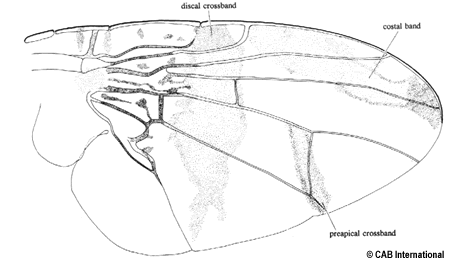 |
|
Rhagoletis - cell bcu with a short extension |
 |
|
Bactrocera and Dacus - cell bm twice height of cell bcu |
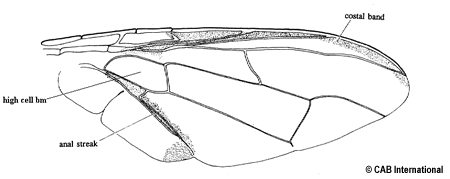 |
|
Dacus - all terga fused |
 |
|
Bactrocera - all terga separate (except terga I and II |
 |
Identification of the Bactrocera zonata species group
|
|
|
| Microtrichiae in basal area of cell br | No microtrichiae in basal area of cell br (applies to a very few other species, e.g. B. oleae) → B. zonata group |
- Other features needed to define the B. zonata group
- Scutum with lateral vittae
- Scutum without medial vitta
- Scutellum without basal setae
- Scutum with anterior supra-alar setae
- Male with a pecten
|
Scutum with lateral vittae
The lateral vittae are the bright yellow stripes either side of the scutum. B. oleae is an example of a species that lacks these bright stripes. |
|
|
|
Scutum without a medial vitta
Left: B. cucurbitae, the melon fly, has a medial bright stripe (vitta) Right: B. zonata |
|
|
|
Scutellum without basal setae
Left: Setae present - no major pests have this (except rare individuals of B. cucurbitae) Right: Setae absent as in B. zonata |
|
|
|
Scutum with anterior supra-alar setae
B. oleae is an example of a species that lacks these setae
|
|
|
|
Male with a pecten
All major pest Bactrocera spp. have this |
|
|
- The B. zonata group
- B. affinis - Shevroy Hills, S. India
- B. armillata - Myanmar
- B. correcta - Widespread pest
- B. tuberculata - Myanmar & Thailand
- B. venefica - Myanmar
- B. versicolor - S. India & Sri Lanka
- B. zonata - Widespread pest
- Some characters that separate species within the B. zonata group
- Colour of scutum
- Facial spots
- Costal band of wing reduced
- Prescutellar setae
- Aculeus (ovipositor tip) shape
|
Colour of scutum
Left: B. zonata, B. affinis, B. versicolor Right: B. armillata, B. correcta, B. tuberculata and B. venefica are black |
|
|
|
Facial spots
Left: Round spots of B. zonata and others Right: Transverse lines of B. correcta |
|
|
|
Costal band of wing reduced
Left: B. zonata and others e.g. B. correcta Right: B. versicolor is similar to this (actually B. dorsalis shown)
|
 |
|
|
Scutum with prescutellar setae
Left: with prescutellar setae Right: B. affinis lacks these setae |
|
|
|
Aculeus (ovipositor tip) shape
Left: B. zonata aculeus is pointed Right: A trilobed aculeus similar to B. affinis (B. latifrons actually shown) |
|
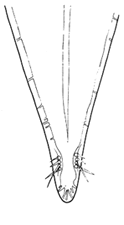  |
Easily confused species (wing pattern also reduced)
- Bactrocera oleae
- only in olive
- darker and no stripes on scutum
- Dacus ciliatus
- only in Cucurbitaceae
- fused terga of abdomen
- B. zonata
- not in above hosts
|
Bactrocera oleae - Only attacks Olea spp. |
|
|
Dacus ciliatus - A pest of Cucurbitaceae |
 |
Larval identification
- The only description was made before modern SEM-based studies
- Therefore, we simply do not know the important characters!
|
|
|
| Bactrocera maggots in Indian Bael (Aegle marmelos), a fruit heavily attacked by B. zonata in its native south Asia |
Bactrocera, 3rd instar larva, lateral view. 1, anterior spiracle. 2, mouth hook. 3, oral ridge. 4, creeping welts. 5, anal lobes. 6, posterior spiracles. |
Good taxonomy … can save billions!
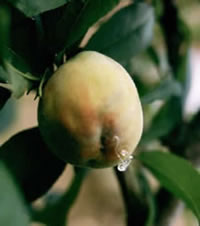
Peach attacked by Bactrocera sp. showing sticky
exudate around oviposition hole

A well stocked stall in a southern Indian market,
with its proud owners

